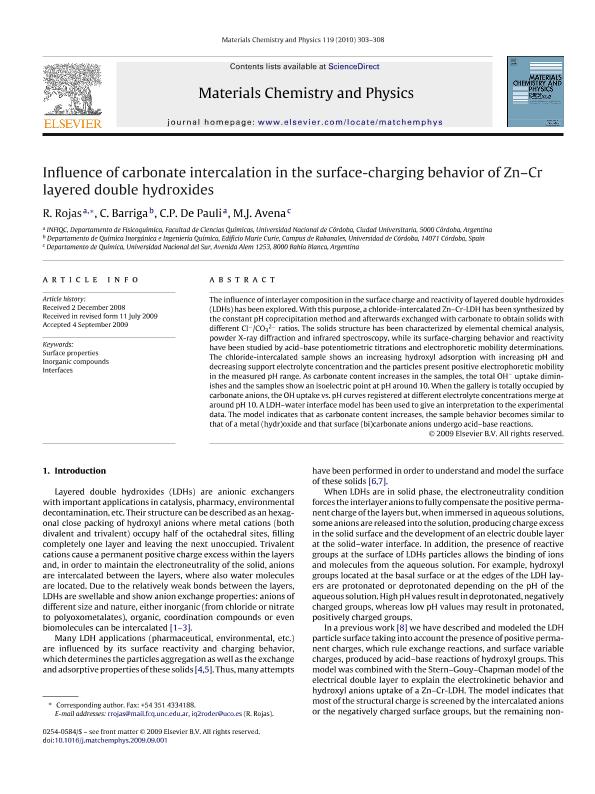Mostrar el registro sencillo del ítem
dc.contributor.author
Rojas Delgado, Ricardo

dc.contributor.author
Barriga, C.
dc.contributor.author
de Pauli, Carlos Primo

dc.contributor.author
Avena, Marcelo Javier

dc.date.available
2018-11-09T14:40:02Z
dc.date.issued
2010-01
dc.identifier.citation
Rojas Delgado, Ricardo; Barriga, C.; de Pauli, Carlos Primo; Avena, Marcelo Javier; Influence of carbonate intercalation in the surface-charging behavior of Zn-Cr layered double hydroxides; Elsevier Science Sa; Materials Chemistry and Physics; 119; 1-2; 1-2010; 303-308
dc.identifier.issn
0254-0584
dc.identifier.uri
http://hdl.handle.net/11336/64070
dc.description.abstract
The influence of interlayer composition in the surface charge and reactivity of layered double hydroxides (LDHs) has been explored. With this purpose, a chloride-intercalated Zn-Cr-LDH has been synthesized by the constant pH coprecipitation method and afterwards exchanged with carbonate to obtain solids with different Cl-/CO32- ratios. The solids structure has been characterized by elemental chemical analysis, powder X-ray diffraction and infrared spectroscopy, while its surface-charging behavior and reactivity have been studied by acid-base potentiometric titrations and electrophoretic mobility determinations. The chloride-intercalated sample shows an increasing hydroxyl adsorption with increasing pH and decreasing support electrolyte concentration and the particles present positive electrophoretic mobility in the measured pH range. As carbonate content increases in the samples, the total OH- uptake diminishes and the samples show an isoelectric point at pH around 10. When the gallery is totally occupied by carbonate anions, the OH uptake vs. pH curves registered at different electrolyte concentrations merge at around pH 10. A LDH-water interface model has been used to give an interpretation to the experimental data. The model indicates that as carbonate content increases, the sample behavior becomes similar to that of a metal (hydr)oxide and that surface (bi)carbonate anions undergo acid-base reactions. © 2009 Elsevier B.V. All rights reserved.
dc.format
application/pdf
dc.language.iso
eng
dc.publisher
Elsevier Science Sa

dc.rights
info:eu-repo/semantics/openAccess
dc.rights.uri
https://creativecommons.org/licenses/by-nc-sa/2.5/ar/
dc.subject
Inorganic Compounds
dc.subject
Interfaces
dc.subject
Surface Properties
dc.subject.classification
Otras Ciencias Químicas

dc.subject.classification
Ciencias Químicas

dc.subject.classification
CIENCIAS NATURALES Y EXACTAS

dc.title
Influence of carbonate intercalation in the surface-charging behavior of Zn-Cr layered double hydroxides
dc.type
info:eu-repo/semantics/article
dc.type
info:ar-repo/semantics/artículo
dc.type
info:eu-repo/semantics/publishedVersion
dc.date.updated
2018-11-05T19:09:01Z
dc.journal.volume
119
dc.journal.number
1-2
dc.journal.pagination
303-308
dc.journal.pais
Países Bajos

dc.journal.ciudad
Amsterdam
dc.description.fil
Fil: Rojas Delgado, Ricardo. Consejo Nacional de Investigaciones Científicas y Técnicas. Centro Científico Tecnológico Conicet - Córdoba. Instituto de Investigaciones en Físico-química de Córdoba. Universidad Nacional de Córdoba. Facultad de Ciencias Químicas. Instituto de Investigaciones en Físico-química de Córdoba; Argentina
dc.description.fil
Fil: Barriga, C.. Universidad de Córdoba; España
dc.description.fil
Fil: de Pauli, Carlos Primo. Consejo Nacional de Investigaciones Científicas y Técnicas. Centro Científico Tecnológico Conicet - Córdoba. Instituto de Investigaciones en Físico-química de Córdoba. Universidad Nacional de Córdoba. Facultad de Ciencias Químicas. Instituto de Investigaciones en Físico-química de Córdoba; Argentina
dc.description.fil
Fil: Avena, Marcelo Javier. Consejo Nacional de Investigaciones Científicas y Técnicas. Centro Científico Tecnológico Conicet - Bahía Blanca. Instituto de Química del Sur. Universidad Nacional del Sur. Departamento de Química. Instituto de Química del Sur; Argentina
dc.journal.title
Materials Chemistry and Physics

dc.relation.alternativeid
info:eu-repo/semantics/altIdentifier/url/https://www.sciencedirect.com/science/article/pii/S0254058409005495
dc.relation.alternativeid
info:eu-repo/semantics/altIdentifier/doi/https://dx.doi.org/10.1016/j.matchemphys.2009.09.001
Archivos asociados
